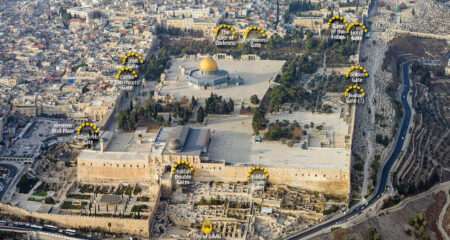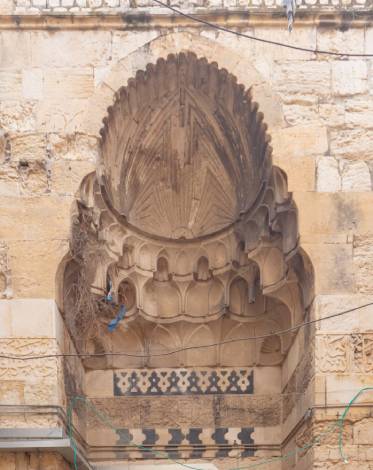The Muslim conquest of the Land of Israel marks the end of the Roman and Byzantine periods and the beginning of the Middle Ages. Contrary to the associations raised by the name, the Middle Ages are not considered to have necessarily been a time of decline and diminished importance.
This period is divided into a number of sub-periods. The first is the Early Muslim period, which in itself includes sub-periods – Umayyad, Abbasid and Fatimid – with the brief Seljuk rule. Then follow the Crusader, Ayyubid and Mamluk periods.
Beginning in the twelfth century, different kingdoms ruled different parts of the country. In the beginning the Crusaders and the Ayyubids split the country between them, and later it was divided between the Crusaders and the Mamluks. Beginning in 1291, the Mamluks ruled the country alone.

The Middle
Ages
Umayyad dynasty
During the time of the Umayyad dynasty, the Islamic Empire extended over huge areas and even threatened Europe (with the conquest of Spain). The Umayyad capital was Damascus. In the Land of Israel, the Umayyads established the administrative city of Ramle, and Jerusalem saw a major building push under Umayyad rule. Two important religious structures were built on the Temple Mount, and palaces and a gigantic bathhouse went up next to the Mount. The southern wall of the Temple Mount was rebuilt and the Gates of Hulda were restored. The Gate of Mercy in the eastern wall may also have been built during this time.
Abbasid dynasty
The Abbasid dynasty brought about the end of the Umayyad dynasty, except for a small Umayyad realm in Spain. The Abbasids, whose main support came from the eastern part of the empire, moved their capital from Damascus to Baghdad. During the Abbasid period, the Land of Israel and Jerusalem did not receive the same investment as they had during the Umayyad period, although Ramle, which had been destroyed in an earthquake on the eve of the Abbasid ascent to power, was restored, and the famed Arches Pool was built at this time. Construction took place elsewhere at this time, including Tiberias.
Fatimid and Seljuk dynasties
The Fatimids were Shi’ite rulers (as opposed to the Umayyads and the Abbasids, who were Sunnis), from Egypt. In 970, the Fatimids conquered the Land of Israel from the Abbasids, but the Abbasid Empire continued in existence.
In the eleventh century an earthquake damaged the walls of Jerusalem, which until that time had included the City of David and Mount Zion. The Fatimid rulers of the city restored the walls along a smaller line, excluding the City of David and the southern part of Mount Zion; this is the line the wall follows to this day. Of particular note is the Fatimid ruler Al-Hakim, who persecuted non-Muslim minorities, especially Christians. He destroyed their churches, including the Church of the Holy Sepulchre, which was only restored during the time of his successors. In 1071, the land was conquered by the Seljuk Muslims, a rising power that defeated the Byzantines, who threatened the Islamic world. The Seljuks ruled the land until 1098, when the Fatimids returned for a number of months before the Crusader invasion of the Middle East.
Crusader period
In 1099 the Crusaders conquered Jerusalem and massacred both its Jewish and its Muslim inhabitants. The Crusaders ruled the city until 1187, when their kingdom was taken by the Muslim leader Saladin al-Ayyubi. In 1192 the Crusaders founded a second kingdom, smaller in size, which was destroyed by the Mamluk Muslims in 1291.
Jerusalem was the capital of the first Crusader kingdom, but during the second Crusader kingdom they ruled only part of the city for only 15 years, and moved their capital to Acre. In Jerusalem they built markets, churches and hospitals within city limits that were about the same size as the Old City of today.
Throughout most of this period Jews were not allowed to live in the city, but toward the end a small number were given permission to live near the Tower of David, near the king’s palace.
Mamluk period
In 1260, Jerusalem was conquered by the Mamluks, Muslims from Egypt who had taken control there a decade before. Jerusalem became a marginal city in the Mamluk Empire and its walls apparently remained in ruins. However, many buildings were built in the city – around and on the Temple Mount – among them markets, bathhouses, religious schools, mosques, tombs, etc.
During this time the Franciscan Order became the representative of the Catholic world in the Land of Israel. The Muslims took over the Tomb of King David and the Room of the Last Supper on Mount Zion, and the synagogue of the Jews was destroyed by the Muslim community. It was subsequently rebuilt on orders of the sultan, who lived in Cairo.
















